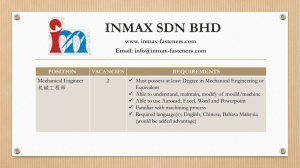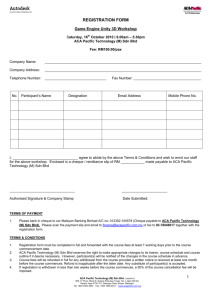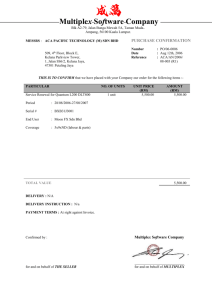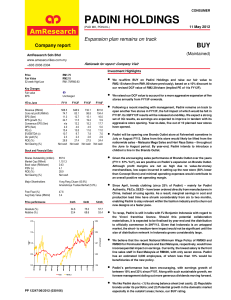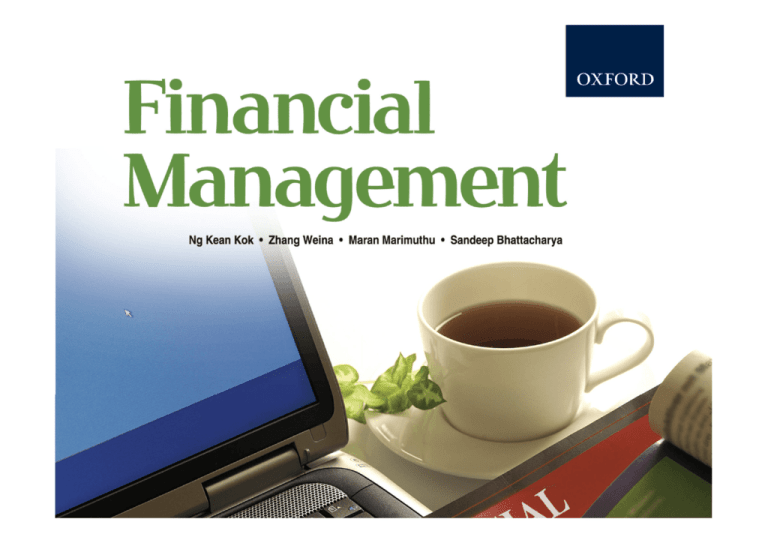
Financial Management
© Oxford Fajar Sdn. Bhd. (008974-T) 2010
All Rights Reserved
Ch. 2: 1
Chapter 2
Financial Environment
Financial Management
© Oxford Fajar Sdn. Bhd. (008974-T) 2010
All Rights Reserved
Ch. 2: 2
Learning Objectives
At the end of this chapter, you should be able to:
Identify the basic forms of business in Malaysia and
explain the respective strengths and weaknesses
Identify, describe and explain the various financial
statements that businesses produce
Prepare simple financial statements of a firm
Show an appreciation of the makeup of financial
markets in Malaysia
Distinguish between primary and secondary
markets
Financial Management
© Oxford Fajar Sdn. Bhd. (008974-T) 2010
All Rights Reserved
Ch. 2: 3
Forms of Business
Sole Proprietorship
Partnership
Company (Firm)
Financial Management
© Oxford Fajar Sdn. Bhd. (008974-T) 2010
All Rights Reserved
Ch. 2: 4
Sole Proprietorship
Owned by a single person
Owner has title to the business’ assets, and all of
the business’ liabilities as well.
No limitation as to the amount of gains and losses
that the owner shall be entitled or liable to.
Owner is entitled to all of the business’ profits, and
yet must absorb any and all losses that may arise.
Financial Management
© Oxford Fajar Sdn. Bhd. (008974-T) 2010
All Rights Reserved
Ch. 2: 5
Sole Proprietorship (cont.)
Advantages:
No legal requirements other than the need to
register the business with the Registrar of
Business
Cheapest form of business
Business incurs no corporation or income tax –
tax liability borne by the individual owner
Life of business depends on the life of the owner
(ceases upon death of the owner) or at the choice
of the owner
Financial Management
© Oxford Fajar Sdn. Bhd. (008974-T) 2010
All Rights Reserved
Ch. 2: 6
Sole Proprietorship (cont.)
Disadvantages:
Funds in business limited to amount that the sole
proprietor has personally
Sole proprietor has unlimited liability for business
debts and liabilities.
No distinction and separation is made between
business and personal assets
Creditors may claim the sole proprietor’s personal
assets when the business’ assets cannot pay the
creditors.
Financial Management
© Oxford Fajar Sdn. Bhd. (008974-T) 2010
All Rights Reserved
Ch. 2: 7
Partnership
Coming together (association) of two or more
individuals for a common purpose to operate a
business together for profit.
Two subcategories of partnership:
i. General partnerships
ii. Limited liability partnerships
Financial Management
© Oxford Fajar Sdn. Bhd. (008974-T) 2010
All Rights Reserved
Ch. 2: 8
General Partnerships
All partners agree to provide an agreed portion of
funding and work contribution into the joint
business.
To share in the resulting profits and losses, on a
pre-agreed profit sharing ratio
Each partner shall be liable, jointly and severally,
for the losses incurred by the business.
Financial Management
© Oxford Fajar Sdn. Bhd. (008974-T) 2010
All Rights Reserved
Ch. 2: 9
Limited Liability Partnership
Liability of certain partners shall be limited (restricted)
to the amount of capital put in by the said partner into
the partnership.
However, there must exist at least one partner who is
not a limited liability partner.
Losses (and liabilities) incurred by the business that
cannot be met by the capital contributed by the
partners shall be borne by this non-limited liability
partner(s).
Limited liability partners may not be allowed to
participate in the management and daily running of the
business.
Financial Management
© Oxford Fajar Sdn. Bhd. (008974-T) 2010
All Rights Reserved
Ch. 2: 10
Advantages of Partnerships
Inexpensive and easy to form.
Management control resides with the general
partners.
Financial Management
© Oxford Fajar Sdn. Bhd. (008974-T) 2010
All Rights Reserved
Ch. 2: 11
Disadvantages of Partnerships
General partners have unlimited liability on all
debts incurred by the partnership (but contrast
for limited liability partnerships).
Partnership is terminated when one partner dies
or withdraws from the partnership arrangement.
It may be difficult to raise additional funding.
Equity contribution is limited to the partner’s
ability and desire to contribute funds to the
partnership.
Income from a partnership is taxed as personal
income of the partners.
Financial Management
© Oxford Fajar Sdn. Bhd. (008974-T) 2010
All Rights Reserved
Ch. 2: 12
Company (Firm)
Given its legal status by the Companies Act, 1965
Subject to the laws as set out in the Act, for which a
company must be incorporated with the Registrar of
Companies, under Companies Commission of
Malaysia
Must have a Memorandum and Articles of
Association (M&A)
Separation of ownership and control
Financial Management
© Oxford Fajar Sdn. Bhd. (008974-T) 2010
All Rights Reserved
Ch. 2: 13
Advantages of Having a
Company (Firm)
Ownership can be transferred by way of transfer
of shares from one shareholder to another.
Companies can have unlimited life.
Shareholders’ liability limited to the amount
invested in the company.
Easier for a company to raise additional funding
from external providers of finance (e.g. bank)
Financial Management
© Oxford Fajar Sdn. Bhd. (008974-T) 2010
All Rights Reserved
Ch. 2: 14
Disadvantages of Having a
Company (Firm)
Annual accounts would have to be prepared—
responsibility of the directors of the company
Accounts of the company would have to be audited
by external auditors.
Filing of financial statements and annual returns
must be made with the Registrar of Companies
every year.
Annual and extraordinary general meetings must be
conducted.
At least two directors must be appointed
Is subject to corporation tax
Financial Management
© Oxford Fajar Sdn. Bhd. (008974-T) 2010
All Rights Reserved
Ch. 2: 15
Financial Statements of a
Company
Income Statement—presents the revenues and
expenses, and resulting net income or loss of a firm
for a specified financial period
Statement of Financial Position—reports the assets,
liabilities and shareholders’ equity of a firm as at a
specific date
Statement of Cash Flows—summarizes the
information concerning the cash inflows (receipts)
and outflows (payments) for a specified financial
period
Financial Management
© Oxford Fajar Sdn. Bhd. (008974-T) 2010
All Rights Reserved
Ch. 2: 16
Income Statement
Financial Management
© Oxford Fajar Sdn. Bhd. (008974-T) 2010
All Rights Reserved
Ch. 2: 17
Statement of Financial
Position
Financial Management
© Oxford Fajar Sdn. Bhd. (008974-T) 2010
All Rights Reserved
Ch. 2: 18
Statement of Cash Flows
Financial Management
© Oxford Fajar Sdn. Bhd. (008974-T) 2010
All Rights Reserved
Ch. 2: 19
Financial Markets
Perform the important economic function of
channelling funds from the providers (households,
other firms and government) that have surplus
funds to those who have a shortage of funds (and
hence, require funds).
Financial markets bring these two groups
together:
a) Providers
b) Users of finance
Financial Management
© Oxford Fajar Sdn. Bhd. (008974-T) 2010
All Rights Reserved
Ch. 2: 20
Financial Markets (cont.)
The roles of financial markets include:
Facilitation of savings by individuals by allowing
them to consume less today (savings) to be able to
consume more in the future
Platform to raise financing by the users (firms) of
finance
Channel whereby demand for and supply of funds
can interact and arrive at a suitable market price for
funds
Provision of financial services that allow participants
to work out and balance their risk tolerance and
expected returns
Financial Management
© Oxford Fajar Sdn. Bhd. (008974-T) 2010
All Rights Reserved
Ch. 2: 21
Debt vs. Equity Securities
Debt securities—contractual obligations by the
firm to repay borrowings, in the form of interest
and principle
Equity securities—comprise of ordinary and
preferred shares; represents non-contractual
claims by the holders of this type of security on
the firm’s residual cash flows after having settled
with the debt holders
Financial Management
© Oxford Fajar Sdn. Bhd. (008974-T) 2010
All Rights Reserved
Ch. 2: 22
Primary vs. Secondary
Markets
Primary markets—funds are raised from providers
of finance by firms that require such funds
Firms issue shares and debt instruments (bonds
or loan stock) to providers of finance.
Secondary markets—investors (providers of
finance) buy and sell shares, bonds, loan stocks
and so on
Financial Management
© Oxford Fajar Sdn. Bhd. (008974-T) 2010
All Rights Reserved
Ch. 2: 23
Money Markets
Markets for debt securities that will be repaid in the
short term (< one year)
Relates to a group of loosely connected markets,
e.g. dealer markets
Main player in the role as dealer is the banks;
particularly active in this market, both as lenders
and borrowers
Large firms lend when they have surplus cash
(invest in Certificate of Deposits, Commercial
Paper, Treasury Securities, Bankers’ Acceptances,
etc.) and borrow when they are short of money
Financial Management
© Oxford Fajar Sdn. Bhd. (008974-T) 2010
All Rights Reserved
Ch. 2: 24
Capital Markets
Markets for long-term debt (i.e. debt securities
that will be repaid after more than one year) and
equity
Financial Management
© Oxford Fajar Sdn. Bhd. (008974-T) 2010
All Rights Reserved
Ch. 2: 25
Capital Markets (cont.)
Long-term debt
Bonds, debentures or loan stocks
Term loan
Leasing
Industrial hire purchase
Contractual (legal) obligation to repay borrowings
Interests and principle
Financial Management
© Oxford Fajar Sdn. Bhd. (008974-T) 2010
All Rights Reserved
Ch. 2: 26
Equity
Shares are equity in a firm
Represents ownership
Residual interest in a firm—shareholders can only
claim on their share of earnings and assets of a
firm after the distribution of earnings or assets has
been made to other claimants (debt holders)
Shareholders have dividend rights, voting rights,
liquidation and pre-emptive rights.
Financial Management
© Oxford Fajar Sdn. Bhd. (008974-T) 2010
All Rights Reserved
Ch. 2: 27
Primary Market
Used when firms (and government) first issue
securities for funds
Firms engage into two types of primary market
activities—public offerings and private placements
Public offerings—issue of debt/equity securities to
the public at large
Publish prospectuses and advertise in national
newspapers, calling for subscriptions for the
securities by the public
Financial Management
© Oxford Fajar Sdn. Bhd. (008974-T) 2010
All Rights Reserved
Ch. 2: 28
Primary Market (cont.)
Issues underwritten by merchant banks,
stockbroking companies or investment banks
Firms concerned would have to be listed with
Bursa Malaysia
Private placements—firms may issue debt or
equity to certain parties (and not to the public at
large) after having undertaken private discussions
and negotiations
Providers of finance under this category include
pension funds, insurance firms, banks and
selected individual investors.
Financial Management
© Oxford Fajar Sdn. Bhd. (008974-T) 2010
All Rights Reserved
Ch. 2: 29
Secondary Markets
Holder of a security sells the security concerned
to another investor
Provide the means for transferring ownership of
a security (debt/equity)
Financial Management
© Oxford Fajar Sdn. Bhd. (008974-T) 2010
All Rights Reserved
Ch. 2: 30
Derivative Markets
Financial instrument that is derived from other
financial securities or some other underlying
asset
Examples of derivatives are forwards, futures,
options and swaps.
Financial Management
© Oxford Fajar Sdn. Bhd. (008974-T) 2010
All Rights Reserved
Ch. 2: 31
Derivative Markets (cont.)
Forward contract—agreement to buy or sell an
underlying asset at some time in the future, at a
price agreed upon today
Tailor-made to suit the participant’s or investor’s
requirement
Futures—agreement by the investors or participants
to deliver or take delivery (buy or sell) an underlying
asset some time in the future at a price agreed
upon today
Futures are standardized contracts and are typically
traded through an exchange.
Financial Management
© Oxford Fajar Sdn. Bhd. (008974-T) 2010
All Rights Reserved
Ch. 2: 32
Derivative Markets (cont.)
Option gives the holder the right but not the
obligation, to buy or sell a fixed quantity of
asset, at a pre-specified price, on or before a
fixed future expiry date.
A call option gives the holder the right to buy an
asset whereas a put option gives the holder the
right to sell an asset.
Financial Management
© Oxford Fajar Sdn. Bhd. (008974-T) 2010
All Rights Reserved
Ch. 2: 33
Derivative Markets (cont.)
Swap—agreement to exchange a series of
payments sometime in the future
Fixed-for-floating interest rate swap—one party
pays fixed interest and receive floating interest,
whereas the other party would be the one to pay
floating interest and receive fixed interest
Currency swap
Financial Management
© Oxford Fajar Sdn. Bhd. (008974-T) 2010
All Rights Reserved
Ch. 2: 34


